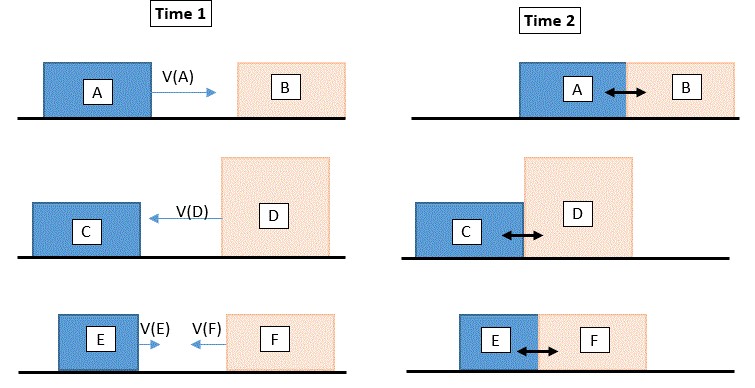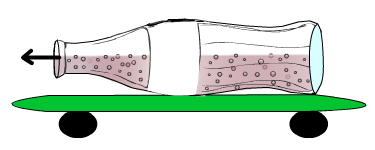

Newton's Third Law is sometimes stated as "For every action, there is an equal and opposite reaction." This means that for any force that is exerted on an object, there is an equal and opposite force.
For example, any time two objects are touching each other, the two objects push on each other with the same amount of force, but in opposite directions.
Example. In the picture below, two objects (A and B; C and D; E and F) and their initial velocities are shown at Time 1. (Objects B and C are initially at rest.)

They first make contact with each other a bit later, at Time 2. The forces of the objects on each other are shown at Time 2 as double-headed arrows. In each case, when the two objects are in contact and pushing on each other, they will exert forces on each other that are equal in amount and opposite in direction:
If all of these objects are made of the same materials, there would be the same amount of compression of both objects near the areas of contact between the two objects.
Gravitational forces also "obey" Newton's Third Law.
Example of Newton's Third Law: Car/Truck. For a more specific example, imagine a car safety test in which a 3,000 kg truck and a 1,000 kg car collide, each with a crash-test dummy driver inside. The force of the truck on the car would be equal to the force of the car on the truck. You might think this sounds crazy, and that the truck would exert more force on the car than the opposite. After all, the crash-test dummy driver in the car would be more damaged, right?

It is true that the crash-test dummy in the car would be more damaged than the crash-test dummy in the truck (just like a human driver would be hurt more in the car than truck).
Understanding why the crash-test dummy in the car is more damaged than the crash-test dummy in the truck—even though the truck and car exert the same force on each other—is a bit complicated...
When the car and truck collide, they exert the same total force on each other. But, mass resists changes to motion. And the more mass an object has, the more it resists changes to its motion from the same force. So, during the car-truck impact, the truck will slow down—or decelerate—less than the car. In other words, the truck's velocity will change less over the same amount of time (of the impact) compared to the car's velocity. If the car and truck are moving at the same speeds before they collide, the car will actually change its direction during the collision, resulting in a greater change in motion.

Because they are wearing seat belts and have airbags, which keep them on their seats, the crash-test dummies in the car and truck will decelerate at the same rates as their vehicles. So, the crash-test dummy in the car will experience a greater deceleration than the crash-test dummy in the truck. For the car crash-test dummy to experience a greater deceleration than the crash-test dummy in the truck, there must be more force acting on the crash-test dummy in the car from the seat belt and airbag. This greater force on the crash-test dummy in the car from the seat belt and airbag is more likely to damage the crash-test dummy (or cause injuries to a human driver).
This idea is shown by Newton's Second Law, in which for a given direction:
When only the force of the collision (Fc) is acting on the truck and car (the same force acting on both the truck and car), Sum of forces = Fc :
So,
So, according to Newton's Second and Third Laws, the truck (and its driver) will have an acceleration that is only 1/3 the acceleration of the car (and its driver). Or, the car/driver's acceleration is three times the truck/driver's acceleration.
Aside: Another reason you might think that the force of the truck on the car might be greater than the force of the car on the truck is that you might have seen accidents, where the cars were damaged more than the trucks involved. But this due to several reasons. First, cars are shorter than trucks, and often, the front end of the car will go under the (very strong) frame of the truck during a collision. Also, trucks are more massive (with larger/more massive engines) and are often made of stronger metals than cars. Because of this, it takes MORE force to damage a truck to the same extent as a car. In other words, the same force will do less damage to a truck than to a car (even if the force is applied to the same place on both vehicles).
Other examples of Newton's Third Law:
When you swim, you push on the water with your hands with the same force that the water pushes on your hands. You can feel this reaction force of water pushing against your hands (and resisting your motion) when you move your hands through water.
A CO2 bubble in soda breaks away from the inside of the soda bottle and rises to the surface of the soda. The liquid right below the bubble pushes up on the bubble with the same force that the bubble pushes DOWN on the liquid right below the bubble. The more bubbles there are rising to the surface of soda, the greater the downward reaction force of the bubbles pushing down on the liquid below will be!
And there are many, many, many, other examples of Newton's Third Law. In fact, any time two objects come in contact with each other, Newton's Third Law applies.
